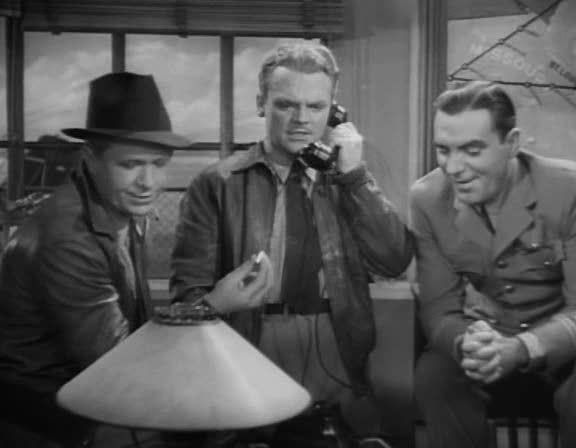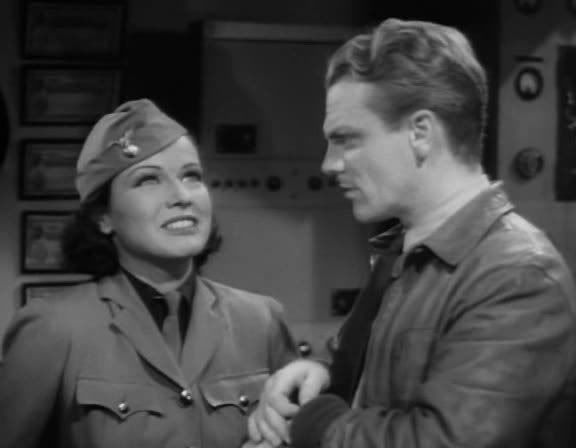
[This is a contribution to the Early Hawks Blog-a-thon hosted right here at Only The Cinema. It will run from January 12 to January 23, 2009.]
Throughout Howard Hawks' early work, it has consistently been apparent that the director's signature themes and concerns were fully formed at least by the time he began making sound films in 1930, and that many of these little-seen films laid the aesthetic groundwork for Hawks' more famous later successes. It is therefore not surprising that Ceiling Zero, one of several early Hawks pictures centered around aviation, is a prototypical Hawks film in many ways. What is surprising is that, although the film most obviously looks forward to the moody, mortality-obsessed Only Angels Have Wings, it also plays out like an early take on the screwball comedies that Hawks would come to master so completely in the next few years. In fact, despite the aviation setting, the first half of Ceiling Zero plays out more like His Girl Friday than any of Hawks' other flying pictures: the fast-paced dialogue flies by with much more zoom and pizazz than any of the airplanes. The film has the snap and energy of a classic screwball farce, as ace pilot Dizzy Davis (James Cagney) flies back into town to be reunited with his old friends Jake Lee (Pat O'Brien) and Tex Clarke (Stuart Erwin).
The three men were friends at the dawn of the aviation era, when there were no rules and daredevil pilots expanded the boundaries of the possible, often at the cost of their own lives. These three survived, and now Lee has settled in as the head of a small airline, running regular passenger and mail flights through treacherous weather, with Tex as one of his top pilots. Soon enough, Dizzy, who is mostly known these days as a wild womanizer with an uncontrollable urge to pull stunts both on the ground and high above it, joins the team as another pilot. The film's plot feels like a trial run for Only Angels Have Wings, with the pilots risking their lives and making time with girls, the constant threat of death hanging over their heads in the foul weather. And yet, the first half of the film has a jovial atmosphere, driven by the crackling, propulsive dialogue of the friends' joyful reunion. The writing doesn't quite have the sharp wit of later Hawks comedies, but the script is dotted with great one-liners, and Hawks gets the most out of his cast's natural talent for humor. All three actors are light on their feet, more than capable of handling the crackerjack pace. O'Brien especially has a manic intensity that gives each of his lines a certain irresistible urgency, as he barks out orders and then switches deftly to ribbing his buddies. Cagney keeps up well, and Erwin, as the relatively laconic, drawling Texan of the bunch, provides a slow but steady counterpoint, hilarious in his own way as the dim-witted, henpecked husband who nevertheless insists that he "wears the pants" in his house.

These early scenes are a blast to watch, as the rough-and-tumble Dizzy tries to incorporate himself into the regular routines of a commercial airline, as well as cozying up to cute flight trainee Tommy Thomas (a smiley, charming June Travis). Dizzy's banter with Tommy, their playful flirtation, would fit nicely into any of Hawks' later relationship comedies, with the clever trading of innuendos and the slow development of mutual respect through rapid patter. Like many a later Hawks heroine, Tommy proves to be Dizzy's equal in verbal sparring and playfully disguised come-ons. She may be 15 years his junior and less experienced than him as both a pilot and a lover, but she's able to stand up and trade quips with the best of them: and what better way to judge the quality of a Hawksian woman than by her verbal dexterity?
The film also features many scenes clustered around telephones, which have often played a decisive role in Hawks' films. The phones take on a more serious function later on in the film, but in the early stretches there are several brilliantly staged comedic sequences staged around the phone, an early incarnation of similar scenes in His Girl Friday and The Big Sleep. Both Tex and Dizzy take turns on the phone, trying to smooth things over with women on the other end as their wisecracking friends pass wry commentary back and forth, occasionally trying to sabotage the call with their barbs and jokes. It's great fun, establishing the men's typically Hawksian rivalry and camaraderie.
Ultimately, though, the vibrant humor of the film's first half is primarily a set-up for a startling midway shift into often harrowing drama. The light tone had minimized the dangers of this milieu, drawing attention away from the constant threat of death that otherwise hung over these men. This dark mood creeps slowly back in during an extended sequence that forms the film's centerpiece, in which one of the pilots is lost up in a foggy sky with zero visibility and a radio that's starting to malfunction. Trapped in the fog, with no contact with the airfield to help guide him down, the pilot must try to land on his own, while the frantic airport personnel wait in the darkness, desperately trying to make contact. It's a startlingly effective sequence, achieved with a minimalist, low-budget atmosphere that only adds to the scene's claustrophobic tension. Hawks was working with a tight budget and basically a single set: almost all of the film's action takes place within the starkly designed airport control room or in one of the plane cockpits against an equally minimal rear projection backdrop of smoke and dark clouds.

What's interesting is that the tragic subtext of this scene is rooted in the masculine codes of honor established by these men, the kind of codes that Hawks frequently glorified. One of the film's opening scenes establishes the price of cowardice when one pilot, frightened flying blind in the fog with no radio contact, bails out of the plane and parachutes to safety. His decision is seen as a loss of nerve, and he loses his spot as a pilot. This young pilot's moment of humiliation lingers, unmentioned but implicit in the similar staging of the two sequences, throughout the later scene, highlighting the impossibility of simply jumping to safety. It becomes a point of honor, of masculine pride, to land the plane or die trying.
This sequence, with its horrifying, fiery denouement — Hawks economically suggests the carnage by framing the control room staff in shadowy silhouettes at the windows, the flames licking up outside — is an irreparable gash in the surface of the film, cutting short the light comedy and buoyant romance of the earlier scenes. It's not a flippant switch in tone, either; the film's transition from comedy to drama doubles as an indictment of Dizzy, of his childish lack of responsibility and seriousness. The film sobers up at the same moment that he does, forcing the audience to recognize the more unpleasant qualities in the fun, lively guy who was such a lovable rogue not long before. Which is not to say that the switch to drama completely works, either, and some of the dramatic contrivances of the film's second half are as groan-inducing as they are predictable. Hawks would be able to handle the film's themes of sacrifice, redemption, friendship and loyalty much more naturally and poetically in Only Angels Have Wings, which is pretty much the pinnacle of this kind of film. Here, the film's messages sometimes come across with sledgehammer subtlety, and only Cagney's sympathetic, nuanced performance prevents the film from completely descending into a maudlin slopfest. Cagney is able to portray depths to Dizzy — particularly in terms of his feelings about Tommy — that simply aren't there in the script, and he keeps the film's second half taut and interesting even when the melodrama threatens to overwhelm him.
Still, despite this uneven second half, Ceiling Zero is a fine film as a whole, one whose disparate halves would provide the templates for several later Hawks films in many genres. The film is a much better low-key comedy than it is a drama, but it's often so much fun, and so crisply acted and directed, that it's very easy to overlook its comparatively mild weaknesses.

2 comments:
I've been enjoying your detailed analysis of these Hawks films. This one, and some others, I've not seen yet, but I will at some point, encouraged by your interesting essays.
I've just reread your review and am especially struck by your point about the shift from comedy to seriousness working as an indictment of Dizzy - this seems just right. This will be a point for me to bear in mind when watching other movies with a similar shift in mood.
I had also wondered why it is that Tex is so determined to land the plane rather than saving himself - unless he has an instruction from his superior. Your explanation about it becoming a point of honour to land the plane or die trying suddenly makes sense of this for me. Thanks again for organising the whole blogathon and for posting all your thought-provoking reviews of these early Hawks films.
Post a Comment